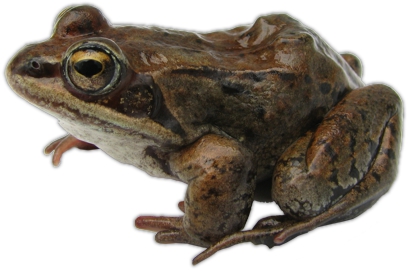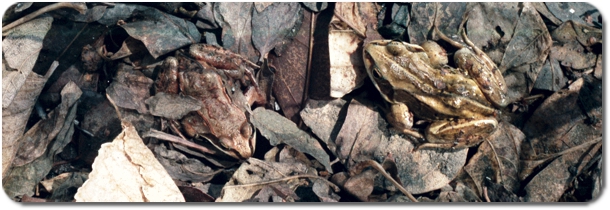Wood Frog

What it looks like
The Wood Frog is a medium sized frog. Its body is about 5 cm long. With its legs stretched out it is about 10 cm long. They can be reddish brown to dark brown in colour, but always have a dark triangle behind the eye. The belly is cream coloured.
Look-alikes
Wood Frogs look a little like Northern Leopard Frogs, but the Wood Frog's brown colour and dark triangle behind the eye lets you tell them apart. Sometimes Northern Leopard Frogs can be light brown, but they still have black spots all over. Wood Frogs don't have big spots.
Name
The Wood Frog gets its name because it lives in forests, or woods.
Scientific Name
The Green Frog's scientific name is Lithobates sylvaticus. Learn what that means on this page: Scientific Names.
Where it lives
Wood Frogs live in forests, but sometimes in meadows or marshes, too. This frog can be found right across the central and northern parts of North America. Wood Frogs live in all parts of Manitoba.
Where Wood Frogs live in North America.
Habits
In summer Wood Frogs hunt for food at night and rest in day time. In spring and fall Wood Frogs can be active any time of the day. They spend winter under the leaves or under logs on the forest floor where they can freeze solid.
Food web
Wood Frogs eat insects, worms and other small invertebrates.
Wood Frogs are eaten by snakes, birds such as herons or crows, and mammals such as raccoons, skunks and weasels. Their tadpoles are eaten by shorebirds, snakes, turtles and large aquatic insects.
Life cycle
Wood Frogs mate and lay their eggs very early in spring, as early as the first week in April. Most of the breeding is from mid-April to early May. Eggs are laid in ponds filled by melting snow or in small year-round ponds.
| Hear the Wood Frog mating call: |
A female can lay 500 eggs in a round bunch attached to plants on top of the water. The eggs hatch in about a week. The tadpoles can become froglets by late June, about 40 to 50 days after hatching. The new froglets are about 1.5 cm long.
Numbers
The Wood Frog is very common in all of Manitoba. There may be as many as 100 frogs in every hectare of forest.
Special things
Wood Frogs are the colour of dead leaves so they can hide on the forest floor. They spend winter on the forest floor under the leaves and their bodies can freeze solid. Then in spring they warm up and hop away. Wood Frogs can live where there are no lakes, marshes or rivers, because they can freeze in winter and lay eggs in ponds formed by melted snow. Their tadpoles grow so quickly they become froglets before the ponds dry up.

Can you see the Wood Frogs in this picture?
How to find Wood Frogs
Listen for calling males from April to mid-May in southern Manitoba, a little later in the north. Evening is the best time to hear them, but early in the breeding season they will call during the day, too. Wood Frogs are common to see in any moist forest or meadow habitat.
Use by people
Some people study Wood Frogs. They are trying to find out how these frogs can freeze and stay alive. This knowledge might help doctors to treat sick people. More people needing new organs like kidneys could be helped if doctors could learn to freeze the organs so they could be kept longer before being used.
| Got to toads: American Toad | Back to: Amphibians and Reptiles Front Page |
For more on Wood Frogs in NatureNorth.com follow these links:
Wood Frogs! | Wood Frogs in the Classroom! | Frog-Log!
